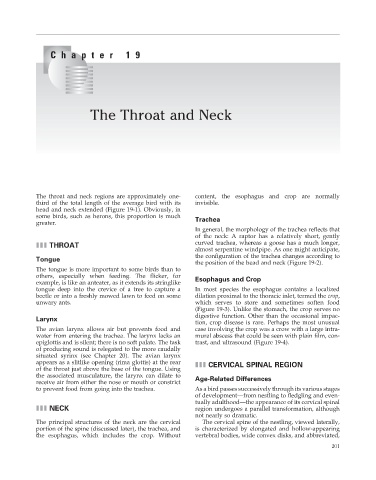Page 205 - Veterinary diagnostic imaging birds exotic pets wildlife
P. 205
Chapter 19
The Throat and Neck
The throat and neck regions are approximately one- content, the esophagus and crop are normally
third of the total length of the average bird with its invisible.
head and neck extended (Figure 19-1). Obviously, in
some birds, such as herons, this proportion is much Trachea
greater.
In general, the morphology of the trachea refl ects that
of the neck: A raptor has a relatively short, gently
III THROAT curved trachea, whereas a goose has a much longer,
almost serpentine windpipe. As one might anticipate,
the configuration of the trachea changes according to
Tongue
the position of the head and neck (Figure 19-2).
The tongue is more important to some birds than to
others, especially when feeding. The fl icker, for Esophagus and Crop
example, is like an anteater, as it extends its stringlike
tongue deep into the crevice of a tree to capture a In most species the esophagus contains a localized
beetle or into a freshly mowed lawn to feed on some dilation proximal to the thoracic inlet, termed the crop,
unwary ants. which serves to store and sometimes soften food
(Figure 19-3). Unlike the stomach, the crop serves no
digestive function. Other than the occasional impac-
Larynx
tion, crop disease is rare. Perhaps the most unusual
The avian larynx allows air but prevents food and case involving the crop was a crow with a large intra-
water from entering the trachea. The larynx lacks an mural abscess that could be seen with plain fi lm, con-
epiglottis and is silent; there is no soft palate. The task trast, and ultrasound (Figure 19-4).
of producing sound is relegated to the more caudally
situated syrinx (see Chapter 20). The avian larynx
appears as a slitlike opening (rima glottis) at the rear III CERVICAL SPINAL REGION
of the throat just above the base of the tongue. Using
the associated musculature, the larynx can dilate to Age-Related Differences
receive air from either the nose or mouth or constrict
to prevent food from going into the trachea. As a bird passes successively through its various stages
of development—from nestling to fledgling and even-
tually adulthood—the appearance of its cervical spinal
III NECK region undergoes a parallel transformation, although
not nearly so dramatic.
The principal structures of the neck are the cervical The cervical spine of the nestling, viewed laterally,
portion of the spine (discussed later), the trachea, and is characterized by elongated and hollow-appearing
the esophagus, which includes the crop. Without vertebral bodies, wide convex disks, and abbreviated,
201
2/11/2008 11:08:11 AM
ch019-A02527.indd 201
ch019-A02527.indd 201 2/11/2008 11:08:11 AM

